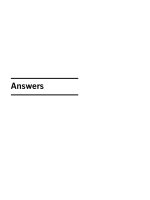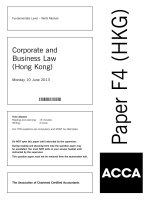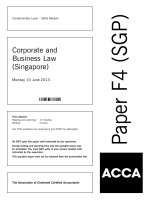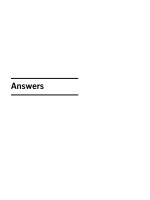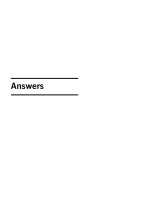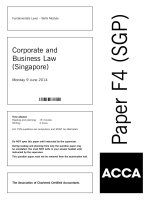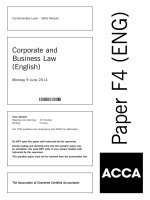ACCA f4 corporate and business law global 2012 jun q
Bạn đang xem bản rút gọn của tài liệu. Xem và tải ngay bản đầy đủ của tài liệu tại đây (69.36 KB, 4 trang )
Corporate and
Business Law
(Global)
Monday 18 June 2012
Time allowed
Reading and planning:
Writing:
15 minutes
3 hours
ALL TEN questions are compulsory and MUST be attempted.
Do NOT open this paper until instructed by the supervisor.
During reading and planning time only the question paper may
be annotated. You must NOT write in your answer booklet until
instructed by the supervisor.
This question paper must not be removed from the examination hall.
The Association of Chartered Certified Accountants
Paper F4 (GLO)
Fundamentals Level – Skills Module
ALL TEN questions are compulsory and MUST be attempted
1
Explain the meaning and operation of the doctrine of precedent in relation to:
(a) the English, or other common law, legal system;
(6 marks)
(b) ONE of the following:
(i) a civil law system;
OR
(ii) a Sharia law system.
(4 marks)
(10 marks)
2
Within the context of the UN Convention on Contracts for the International Sale of Goods, explain the meaning
and effect of:
(a) acceptance of an offer;
(5 marks)
(b) a counter-offer.
(5 marks)
(10 marks)
3
Explain the meaning and function of ‘letters of credits’ in international business transactions, and the procedure
for creating such documents.
(10 marks)
4
Explain the meaning and consequences of the following terms when found at the end of the names of business
organisations:
(a) LLP;
(4 marks)
(b) Ltd;
(3 marks)
(c) plc.
(3 marks)
(10 marks)
5
In relation to company law, explain the meaning of, and distinguish between the rights attached to, each of the
following interests in a company:
(a) ordinary shares;
(3 marks)
(b) preference shares;
(3 marks)
(c) debentures.
(4 marks)
(10 marks)
2
6
In relation to private companies explain the meaning of, and the procedure for passing, the following:
(a) an ordinary resolution;
(2 marks)
(b) a special resolution;
(3 marks)
(c) a written resolution.
(5 marks)
(10 marks)
7
In relation to company law explain:
(a) the grounds on which an action for compulsory winding up may be taken under the Insolvency Act 1986;
(5 marks)
(b) the procedure to be followed in, and the consequences of, an action for compulsory winding up. (5 marks)
(10 marks)
8
Ad Ltd operates a shipbuilding business, which specialises in constructing and modifying ships to order. In 2011, the
company entered into two contracts.
(i)
Ad Ltd entered into an agreement with Box to completely rebuild a ship to Box’s specification for a total contract
price of $7 million. However, just before completion, Box informed Ad Ltd that, due to the downturn in the world
economy, he no longer needed the ship. Ad Ltd immediately started an action against Box for breach of contract.
However, in the week before the case was to be decided in the court, Ad Ltd sold the ship for the same amount
of money that they would have received from Box.
(ii) Ad Ltd also entered into a contract to build a new ship for Cox for a total contract price of $25 million. The cost
of the work was $22 million, with a consequential profit on the contract of $3 million for Ad Ltd. However, on
completion of the ship Cox refused to take delivery. On this occasion, Ad Ltd only succeeded in selling the ship
at the cost price of $22 million.
Required:
Within the context of the UN Convention on Contracts for the International Sale of Goods, advise Ad Ltd:
(a) on the concept of damages and the duty to mitigate losses;
(6 marks)
(b) (i)
whether it can claim damages from Box, and the extent of those damages;
(2 marks)
(ii) whether it can claim damages from Cox, and the extent of those damages.
(2 marks)
(10 marks)
3
[P.T.O.
9
Du is a manufacturer of engineering equipment and has a number of international customers including a long
standing customer, Ez. When Du first did business with Ez the contract contained an express provision that any
disputes should be settled by arbitration. However, after entering into many successful contracts the latest agreement
was simply stated to be on ‘the usual terms’. A dispute has now arisen in relation to this last contract, but Ez refuses
to submit the case to arbitration, insisting that the case should be decided in a court of law.
Du also contracted for the supply of equipment to another international customer, Fo. As this was the first time they
had done business, a detailed contract was drawn up, under which any dispute was to be resolved through the
process of arbitration, the arbitrators being agreed by both parties. When a dispute did arise Fo suggested that Gi
should be appointed as the one of the three arbitrators and Du accepted his proposal. However, Du has since learned
that Gi has previously been employed by Fo as a legal adviser.
Required:
In the context of the UNCITRAL Model Law on International Commercial Arbitration advise Du:
(a) If he can insist on his dispute with Ez going to arbitration;
(5 marks)
(b) whether, and how, he can challenge Gi’s appointment.
(5 marks)
(10 marks)
10 In 2008 Ger was disqualified from acting as a company director for a period of 10 years under the Company Directors
Disqualification Act 1986 for engaging in fraudulent trading.
However, he decided to continue to pursue his fraudulent business and, in order to avoid the consequences of the
disqualification order, he arranged for his sons, Ham and Ive, to register a new company, Just Ltd, with them as the
only shareholders and directors of the company. As neither Ham nor Ive have any business experience Ger arranged
for his accountant Kim to run the business on his instructions. Although Kim took no shares in the company, and was
never officially appointed as a director, he nonetheless assumed the title of managing director.
Lyn, a customer of Just Ltd, suffered considerable loss on account of its fraudulent activity.
Required:
Advise Lyn as to:
(a) the status of Ham, Ive, Ger and Kim as directors in Just Ltd; and
(4 marks)
(b) the potential liability of Ham, Ive, Ger and Kim under company legislation.
(6 marks)
(10 marks)
End of Question Paper
4

